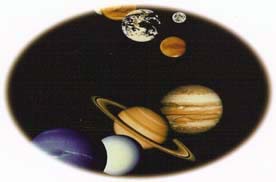This investigation will help you to:
Exploring Planets in the Classroom, Hawaii Space Grant Consortium
Find easy-to-follow, hands-on science activities for exploring Earth, the planets, geology, and space sciences. Each activity has teacher pages which include basic information, methods, and extensions. The student pages may not print exactly as shown, but can be tweaked in a word processor. Grade levels are not given, but most of the activities could easily be used for beginning students in grades 6-10 or adapted for an undergraduate population.
Lunar and Planetary Institute Slide Sets, Lunar and Planetary Institute
What makes this different from other databases out there is the way in which images are grouped. Some excellent sets are the volcanic features of Hawaii compared to features on other planets, the collection of cloud images from space, and Clementine spacecraft images of the moon, which include striking images of the moon with the Earth and sun in the background. Plus, for each image, there are 10mb tiff files available for download if you want a higher-resolution image.
Map-A-Planet, USGS
Access global imagery of the planets and satellites from a variety of missions in an easy-to-use web interface. Customize and download your own image maps of the Moon, Mars, Venus, and other planets and moons. To get started, select a planet or moon from the buttons on the right. If there's more than one dataset to choose from, you'll be presented with a list of available datasets. Finally, choose a level of customization. If you're new to Map-a-Planet, choose the "Easy" version and click the image map to zoom in on an interesting area.
Solar System Lithographs, NASA
NASA has completely revised this popular lithograph set, which includes color images, background information, significant dates, and related websites for all the planets in our solar system. The entire set, or individual lithographs from the series, can all be downloaded as PDF files.
Exploring the Universe, NASA
Find out more about what NASA is currently doing to study the planets and the universe.
A Brief History of NASA, NASA
Find a succinct summary of significant events in NASA’s history ranging from its establishment in 1958 to today’s focus on human missions to the moon and Mars.
The Age of the Universe, Donald E. Simanek
A graph showing estimates of the age if Earth and the universe as a function of the year the estimate was made. The graph ranges from 1700's to present. Following the graph are some very brief descriptions of how the estimates were made. The graph and descriptions provide students with a clear picture of how increased evidence affects the growth of knowledge. Excellent site if you are having trouble teaching one of those standards dealing with the history of science.
Education Resources, University of Hawaii Institute for Astronomy
Resource materials at this Web site were collected and developed as a result of an astronomical educational workshop for top high school teacher-student pairs.

